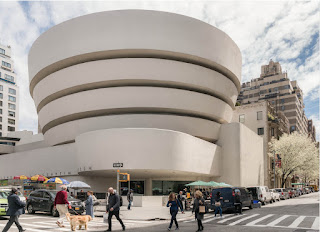It is amazing how tastes change over time, or is it just that we adapt to what is?
Let’s start with something simple like fruit. When I was young if I did not care for fruit and only ate it to be polite when it was served to me. Then one day decades later we were invited to stay at the home of the director of the museum director from the museum in Portland Oregon where Penelope was to become a curator. Every morning for breakfast there was a big bowl with berries and other fruit. Penelope and I both liked it and ever since have made it part of our breakfast at home. Yes, my taste must have changed but there were certainly other factors. We were not in NYC but on the west coast, i.e., better fruit? And the ambience was great …

People change over time: some define it as maturity. We get used to the unknown which scares everyone at first. Frank Lloyd Wright’s (1867-1959), last project opened the same year he died and was nothing like anything anyone in Manhattan had seen before, and certainly not for a museum. It was the circular gallery of the Guggenheim Museum, which was to house, what was a then a collection of contemporary “non-objective” art. The first question that all wanted to know was how do you install flat paintings on curved walls. Its first director, Thomas Messer, was asked that question over and over again. He would chuckle and basically say “You get used to it and then enjoy the process. It becomes a creative effort.” Though I was horrified at the age of 15, I now enjoy it as a landmark on a corner contrasting with the surrounding rectangular high rises.

A half century ago my father gave me a book called, A Child Of Six Could Do It: Cartoons About Modern Art” by George Melly. It was, in my opinion, a put down of abstract art. Understanding is a part of a change in attitude and if you can learn what the artist saw or felt while he was working it helps to reach and move you. I have mentioned before that seeing one Rothko you might think that it is just a few blobs of paint of muted colors on a canvas. I am sorry I could not find the author but on line at The School of Life I found the following, “The most unexpectedly uplifting and consoling artist of the 20th century was the abstract painter Mark Rothko, the high priest of grief and loss who spent the latter part of his career turning out a succession of sublime and somber canvases that spoke, as he put it, of the ‘tragedy of being human’.” I was first surprised to discover this feeling at lunch in a private home where the dining room had Rothkos on the walls. I experienced it again in the contemplative environment of the Rothko Chapel in Houston.
Diane Arbus (1923-1971) is a very well-known name in the annals of photography but when we were collecting I had absolutely no interest in owning one of her works. The reason was simple, they gave me the creeps and still do. In 1971 she committed suicide by both taking barbiturates and cutting her wrists with a razor. A rather gruesome and lonely end. I still don’t wish to own her works but I have come to appreciate them in the light of what she must have been personally going through. Here are 3 Arbus images in one frame.
I am going to end with sculpture that I have never liked and don’t believe I will live long enough to change my mind. For me it is pure kitsch. The artist is Jeff Koons (1955 -). According to the press for a 2009 exhibition at the Tate in London, he “is known for his use of themes and subjects from popular culture (such as toys, ornaments and advertising) characteristic of pop art. But Koons’s work also has qualities that suggest minimalist art.” Maybe so, but I just don’t understand how, in 2019 the estate of magazine magnate S. I. Newhouse, Koons’ stainless steel rabbit sold for 91 million dollars.
That is what is both fun and serious about art, you can make up your own mind and you are neither right nor wrong.






: I sure do agree with you RE: Jeff Koons!!
ReplyDeleteIf most people did he would no longer be an "important" artist!
ReplyDelete